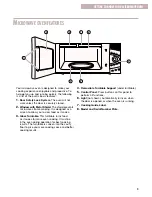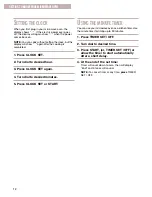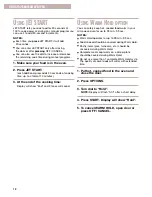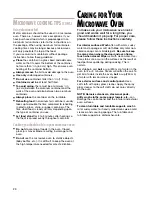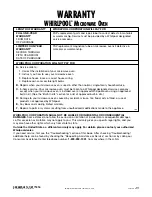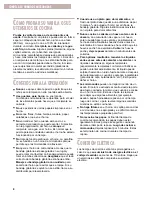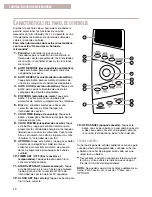
19
M
ICROWAVE COOKING TIPS
C
OOKING
G
UIDE
Amount of food
•
If you increase or decrease the amount of food
you prepare, the time it takes to cook that food will
also change. For example, if you double a recipe,
add a little more than half the original cooking time.
Check for doneness and, if necessary, add more
time in small increments.
Starting temperature of food
•
The lower the temperature of the food being put
into the microwave oven, the longer it takes to cook.
Food at room temperature will be reheated more
quickly than food at refrigerator temperature.
Composition of food
•
Food with a lot of fat and sugar will be heated
faster than food containing a lot of water. Fat and
sugar will also reach a higher temperature than
water in the cooking process.
•
The more dense the food, the longer it takes to heat.
“Very dense” food like meat takes longer to reheat
than lighter, more porous food like sponge cakes.
Size and shape
•
Smaller pieces of food will cook faster than larger
pieces. Also, same-shaped pieces cook more evenly
than different-shaped pieces.
•
With foods that have different thicknesses, the
thinner parts will cook faster than the thicker parts.
Place the thinner parts of chicken wings and legs in
the center of the dish.
Stirring, turning foods
•
Stirring and turning foods spreads heat quickly to
the center of the dish and avoids overcooking at the
outer edges of the food.
Covering food
Cover food to:
•
Reduce splattering
•
Shorten cooking times
•
Keep food moist
You can use any covering that lets microwaves pass
through. See “Getting to Know Your Microwave Oven”
for materials that microwaves will pass through.
Releasing pressure in foods
•
Several foods (for example: baked potatoes,
sausages, egg yolks, and some fruits) are tightly
covered by a skin or membrane. Steam can build
up under the membrane during cooking, causing
the food to burst. To relieve the pressure and to
prevent bursting, pierce these foods before
cooking with a fork, cocktail pick, or toothpick.
Using standing time
•
Always allow food to stand after cooking. Stand-
ing time after defrosting and cooking allows the
temperature to evenly spread throughout the food,
improving the cooking results.
•
The length of the standing time depends on how
much food you are cooking and how dense it is.
Sometimes it can be as short as the time it takes
you to remove the food from the oven and take it to
the serving table. However, with larger, denser food,
the standing time may be as long as 10 minutes.
Arranging food
For best results, place food evenly on the plate. You
can do this in several ways:
•
If you are cooking several items of the same
food, such as baked potatoes, place them in a ring
pattern for uniform cooking.
•
When cooking foods of uneven shapes or
thickness, such as chicken breasts, place the
smaller or thinner area of the food towards the
center of the dish where it will be heated last.
•
Layer thin slices of meat on top of each other.
•
When you cook or reheat whole fish, score the
skin – this prevents cracking.
•
Do not let food or a container touch the top or
sides of the oven. This will prevent possible arcing.
Summary of Contents for MT3070SH
Page 49: ...25 NOTAS ...
Page 50: ...26 NOTAS ...





